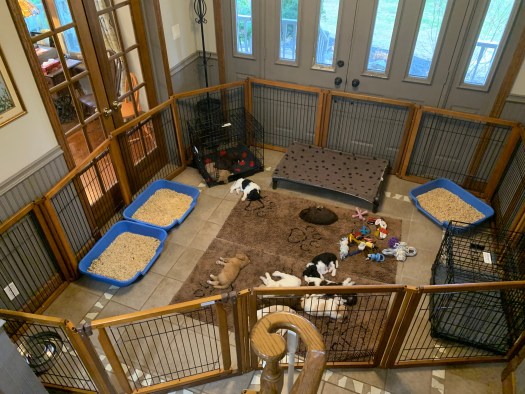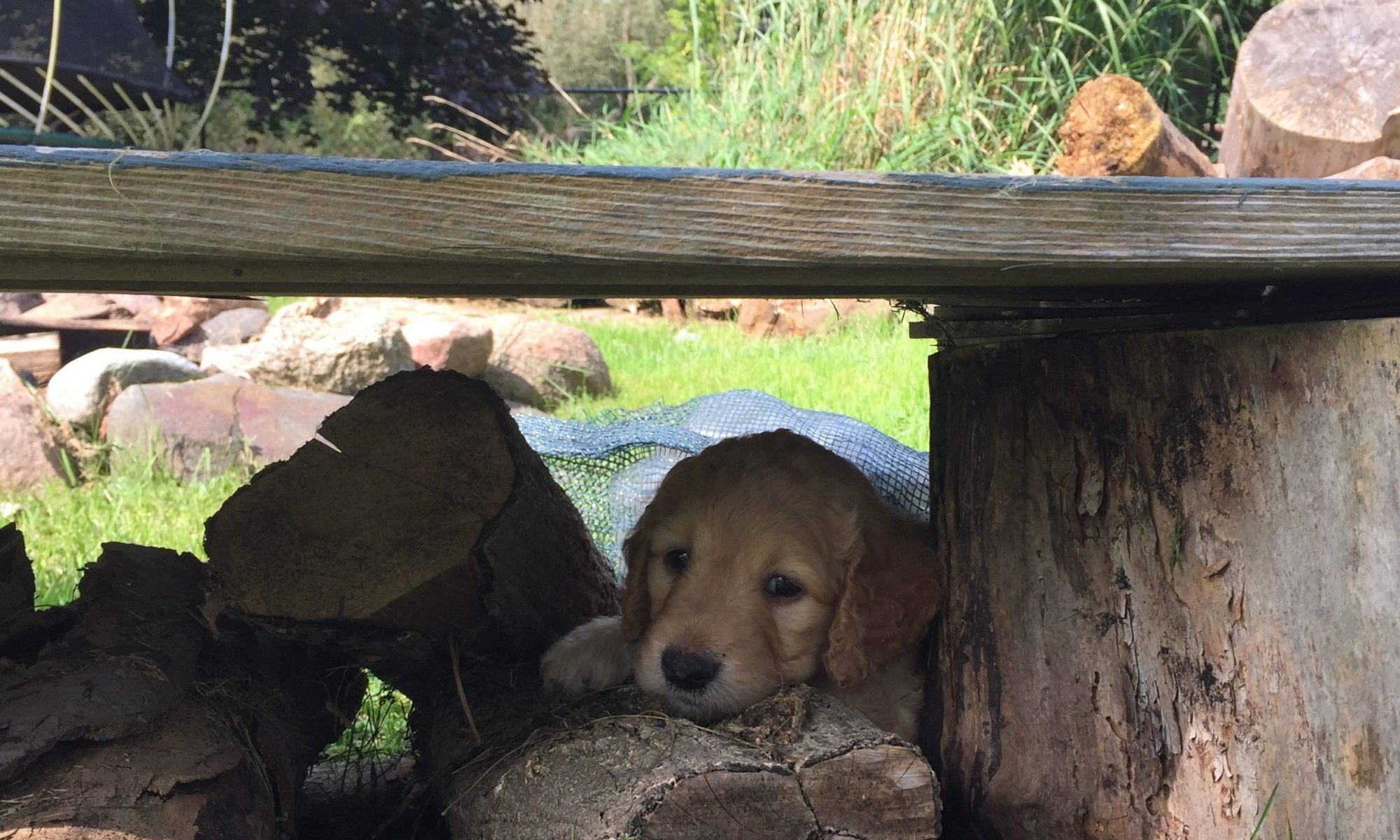Updated 2023
Potty Training starts with the breeder
Why do you train your puppies so young?
Wild dog species have an instinct to keeping their den clean so that the smell doesn’t attract predators. A mama dog also has the same instinct to keep her puppies and puppy area clean. When puppies can start to go potty without the help of their mother, they have a natural instinct to move away from the area where they sleep and eat to go potty.
After puppies are moved to the main floor around 3-1/2 weeks of age, we begin potty training. I spend most of my time during the next three days, putting each puppy in the potty area each time they wake and after they eat. This teaches them there is a “place” to go potty.
Litter Box Training
We now train using a litter box filled with pine pellets in it. This method (as opposed to potty pads) is environmentally friendly because the pine pellets are biodegradable.


Consistency
These pics show how we have set up our puppy area. when we move our puppies to the main floor. Puppies have access to whelping box and potty box only. Until the puppies become more consistent, it is best not to give them too much room.
Constant Cleaning
The potty area must smell like a potty area and the whelping box must smell clean. If a puppy has an accident in the whelping box, it must be cleaned right away . We replace the Vet Bed liners multiply times a day to keep it fresh and clean. Lots of Laundry!!!
The Goal
The goal is for puppies to sleep and play in their whelping box and move to the potty box on their own, when needed.
Larger Puppy Area
Once the puppies are more consistent we give them a larger area.

By teaching puppies “there is a place to go potty”, I believe it makes it easier for their forever family to house train when they go home.
Outside Potty Box
With the introduction of outside play, it is more of a challenge to teach the puppies to “go” in one spot which is the potty box. This is because when a puppy has access to a large area, they move away to “go” but not necessarily in the box. I have been correcting the puppies by taking them to the potty box.
Watch as Pink Collar Girl goes to the potty box all by herself!👏
POTTY TRAINING AT HOME
How do I continue potty training when I take my puppy home?
Take advantage of the early training that we have already started. So when you take your puppy home, you should be teaching them “the acceptable place to go potty is outside“. This means “no potty pads”. If you introduce potty pads, you are teaching your new puppy that it is “okay” to go potty inside your home.
After you bring home your new puppy home, the first thing you need to teach the pup is to walk to the door. Do not carry them. Make the puppy walk or it will not learn to alert you.
Do not use treats when potty training as it takes the dog’s focus off of the business at hand and puts it on the food. You do not want the dog’s brain to be on food when it is time to relieve itself. Keep the focus on the task at hand. Rewards for going potty should be the relief the dog feels when it empties itself and your happiness that the dog did the right thing; ie.; verbal praise, a pet and/or back scratch. Puppies/dogs can feel when humans are happy.
How long can my puppy “hold it”?
Typically to calculate how long a puppy can “hold it” is to take their age in months and add 1 (ie, 2 month old+ 1 = 3 hours.) The older the puppy, the longer they can hold it. I have found large breed puppies can hold it longer as their bladders are larger
Can my puppy “hold” it all night?
It is not likely that your puppy can go the whole night without a potty break when you first bring them home. When your puppy whines in the middle of the night, chances are, they need to go outside for a potty break. Take them to their spot and say “go potty” When they have relieved them-self, give them a short praise and return them to their crate. If you pay too much attention to them at this time, they may continue to wake you up “just for the attention” Don’t feed your puppy or let them drink water too close to bedtime in the evening.
Helpful tips
- Don’t give your puppy too much room to roam your house.
- If you can’t supervise puppy, put them in their crate for a nap.
- Before putting your puppy in their crate, make sure that they have had a outside potty break
- Take your puppy outside frequently—about every two hours
- Take your puppy outside immediately after they wake up, after playing, and after eating or drinking.
- Pick a potty spot outside, and always take your puppy to that spot. This helps them “smell the spot” and know it’s the place to go potty. Use a command word such as “Go Potty”
- Some people like to put their puppy on a leash when going to the potty area. This helps with teaching them to go in a certain spot
- Reward your puppy with verbal praise, a pat and/or back scratch every time they go potty outdoors.
- Feed your puppy 3 meals a day, removing any leftover food when done. This helps you know when your puppy will need to go for a potty break outside. If they always have food available, they need to go potty more frequently which makes it harder to know when they need to go outside.
- Don’t feed your puppy or let them drink water too close to bedtime in the evening.( Take food away after dinner meal, take water away three hours before bed time.)


